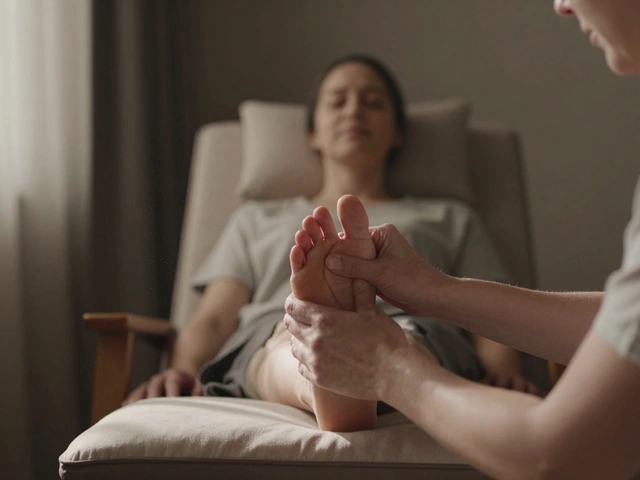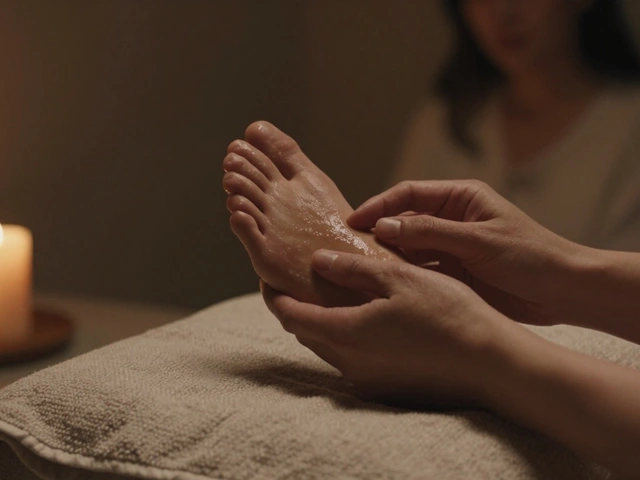BDSM Session Safety Checklist Generator
Create Your Personal Safety Checklist
This tool helps you plan a safe and consensual BDSM massage session. All information is kept private.
Session Details
Boundary Settings
Your Personal Safety Checklist
Activity Checklist
A BDSM massage isn’t just about touch-it’s about power, trust, and sensation. It’s not pornography. It’s not a spa treatment. And it’s not something you stumble into without understanding the boundaries. If you’ve heard the term and felt curious, you’re not alone. Many people wonder what it really means, especially when it’s mixed with the word "massage," which usually brings to mind relaxation and soothing strokes.
At its core, a BDSM massage blends elements of bondage, dominance and submission, and sensory play with intentional touch. The goal isn’t necessarily sexual release, though it can happen. More often, it’s about control, surrender, anticipation, and heightened awareness. One person holds the power to decide what happens, when, and how. The other gives up control, opening themselves to sensations they might not experience in everyday life.
It’s Not What You Think
Most people imagine a BDSM massage as something wild or extreme-whips, chains, pain, and screaming. That’s not wrong, but it’s incomplete. Many BDSM massages are quiet, slow, and deeply intimate. Think cold wax dripping slowly down the spine. A feather brushing just above the skin, then pulled away. Hands wrapped in silk, pressing with just enough pressure to make you hold your breath. A blindfold that turns every breath into a mystery.
Some sessions use no pain at all. Instead, they rely on contrast: heat and cold, tightness and release, silence and sound. A warm oil massage might begin normally, then shift when the receiver is bound in soft rope, unable to move. The touch becomes more deliberate. Every stroke is a decision. Every pause is intentional. The mind, no longer distracted by movement, becomes hyper-aware of sensation.
There’s a reason people describe these experiences as meditative. Without the ability to react, the nervous system recalibrates. Time stretches. Sensations sharpen. What feels like a light brush can become electric. A firm grip can feel like safety. This isn’t about hurting someone-it’s about reshaping how someone experiences their own body.
The Tools Are Simple
You don’t need a dungeon to do a BDSM massage. Most tools are everyday objects with new purpose:
- Soft rope or silk scarves for binding wrists, ankles, or wrists over the head-not to restrict breathing, but to create stillness.
- Feathers, ice cubes, wax candles for contrast and surprise. Cold wax isn’t hot enough to burn; it’s cool enough to make you flinch-and then relax into it.
- Blindfolds to remove vision and heighten touch, sound, and smell.
- Whips, floggers, paddles-used only if agreed upon, and often lightly, to create a sting that fades quickly, leaving a warm glow.
- Massage oils with warming or cooling properties-peppermint, eucalyptus, or vanilla-infused oils that add scent to sensation.
Some practitioners use vibrators or clamps, but these are optional. The real tool is communication. Before any touch, partners talk. They agree on limits. They choose a safe word-something simple, like "red" for stop, "yellow" for slow down. That word must be respected, no questions asked. If someone says "yellow," the touch changes. If they say "red," it stops. Immediately.
Why Do People Do It?
People don’t do BDSM massage because they’re broken or deviant. They do it because it works-for their minds, their bodies, their relationships.
One woman in Canberra told me she started after years of chronic stress. "My body was always on. I couldn’t relax even when I wanted to. With a BDSM massage, I didn’t have to think. I just had to feel. And for the first time in years, I slept through the night."
Another man, a teacher, said it helped him reclaim control in a life where he was always giving it away. "I spend all day managing chaos. At night, I hand it over. I let someone else decide what happens to me. It’s the only time I feel truly free."
Studies from the Journal of Sexual Medicine in 2023 found that people who engage in consensual BDSM report higher levels of trust, communication, and relationship satisfaction than those who don’t. The key word? Consensual. Without it, it’s abuse. With it, it’s therapy, play, connection.

It’s Not About Sex-But It Can Be
Many assume BDSM massage is just a prelude to sex. Sometimes it is. But often, it’s not. Some sessions end with the receiver still bound, quietly breathing, the oil drying on their skin. The pleasure isn’t in climax-it’s in surrender. In the quiet after the storm.
There’s a difference between erotic massage and BDSM massage. Erotic massage aims to arouse. BDSM massage aims to transform. It can lead to arousal, but that’s not the goal. The goal is presence. The goal is trust. The goal is to feel something you can’t feel anywhere else.
How to Start-Safely
If you’re curious, don’t jump into a dungeon. Don’t watch videos and try to copy them. Start small. Start slow. Start with conversation.
- Choose a trusted partner. Someone you already talk to openly. Someone who respects "no."
- Discuss limits. What’s off-limits? What’s exciting? What’s neutral?
- Agree on a safe word. "Red" and "yellow" are common, but pick what feels right for you.
- Start with blindfolds and light touch. No ropes. No pain. Just silence and skin.
- Debrief after. Talk about what worked. What didn’t. What you’d like to try next.
There’s no rush. A single session can last an hour-or five hours. It’s not a performance. It’s a shared experience. And it’s okay if you don’t "like" it. Not everyone does. That’s fine.

Common Myths, Debunked
- Myth: BDSM is abusive. Truth: Abuse is about control without consent. BDSM is about control with full, enthusiastic consent.
- Myth: Only kinky people do this. Truth: People from all walks of life-teachers, nurses, engineers, parents-do this. It’s not about who you are. It’s about what you’re seeking.
- Myth: You need to be into pain. Truth: Many people avoid pain entirely. Sensation, not suffering, is the point.
- Myth: It ruins relationships. Truth: When done right, it deepens them. Communication skills improve. Emotional boundaries become clearer.
What to Avoid
There are hard lines you never cross:
- Never use drugs or alcohol to lower inhibitions. Consent must be clear and sober.
- Never ignore a safe word. Not even once.
- Never assume someone’s limits. Ask. Always.
- Never pressure someone into trying something. Curiosity is fine. Coercion isn’t.
If someone says "no," that’s the end of the conversation. No guilt. No pressure. No "but I thought you’d like it." That’s not BDSM. That’s manipulation.
Final Thought: It’s About Connection
A BDSM massage doesn’t change who you are. It doesn’t make you strange. It doesn’t make you a bad person. It simply opens a door to a different kind of intimacy-one built on trust, not just attraction. It’s about being seen, not just touched. It’s about letting someone else hold your body while you let go of your mind.
It’s not for everyone. But for those who try it-carefully, respectfully, honestly-it can be one of the most profound experiences they’ve ever had.
Is a BDSM massage the same as an erotic massage?
No. An erotic massage is designed to arouse and often leads to sexual release. A BDSM massage focuses on power exchange, sensory control, and psychological immersion. It may or may not lead to sex. The goal is usually surrender, not stimulation.
Do I need special equipment to try a BDSM massage?
Not at all. You can start with just a blindfold, a silk scarf, and some massage oil. Many people use household items-ice cubes, feathers, candles. The most important tool is clear communication, not gear.
Can I do a BDSM massage with my partner if we’ve never tried anything like this before?
Yes-but start slow. Talk first. Agree on limits. Use a safe word. Begin with blindfolds and light touch. No ropes, no pain, no pressure. Let curiosity guide you, not fantasy. Many couples find this builds deeper trust than they expected.
Is BDSM massage safe?
When done with consent, communication, and care, yes. Physical risks are low if you avoid restricting breathing, use safe materials, and never ignore a safe word. Emotional safety is more important-always check in after. If either person feels uneasy, stop and talk.
What if I feel embarrassed or ashamed about wanting to try this?
Feeling that way is normal. Society often misrepresents BDSM as strange or wrong. But research shows people who practice it consensually report higher emotional well-being. Wanting to explore your body and boundaries isn’t shameful-it’s human. Start by reading honest accounts. Talk to a trusted friend. You’re not alone.








